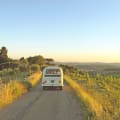Beginner Landscape Painting
We all know that van life lends itself to outdoor sports, but there are also some underrated slower activities you can enjoy on the road. Plein air painting, or painting outside, is a great way to take in natural scenery on rest days. Plus, your paintings can serve as mementos of your travels. In this post, we’ll address some of the mistakes beginners make with landscape painting and offer tips and tricks to take your artwork to the next level.
We recommend investing in a collapsible easel, an artist’s viewfinder, a few brushes of different sizes, acrylic paints, a dish for mixing colors (a plastic yogurt lid works just fine), and a designated water cup. The material you paint on is up to you. You may want to start with a pad of high-quality paper, which takes up less room in a van, then transition to canvases as you become more confident.

Beginner Landscape Painting – Getting Started
1. CREATIVE COMPOSITION
After you’ve found a beautiful location and set up your materials, make use of an artist’s viewfinder to decide on an interesting composition. This small plastic tool works similarly to a camera viewfinder—you hold it in front of you, look through with one eye closed, and choose what to include in the image. With the tool’s frame adjusted to match the proportion of your canvas or piece of paper, you can experiment with different ways to frame the same scene. Consider placing focal elements like mountains or trees off-center in your paintings because, 9 times out of 10, this will be more pleasing to look at.
2. LAY THE FOUNDATIONS
Start by painting the whole canvas with rough shapes in the basic colors making up the scene. Squinting at the landscape helps identify these general areas of color. Once there are no blank spaces left on the canvas, you can begin layering more color, texture, and details on top!

3. DON’T THINK, SEE
A common pitfall for beginners is that they paint things how they think they should look, rather than how they actually look. For example, they might paint a tree with a green cloud-shaped puff of leaves. In reality, the mass of leaves might be wispy and irregularly-shaped or half of the leaves might be golden from the sunlight. To paint more realistic landscapes, get in the habit of using the brush as an extension of your eyes and seeing the scene as a collection of lines and shapes rather than labeled elements.
4. IT’S ALL IN THE CONTRAST
Pay attention to contrasts throughout the painting process. You should have areas with both lighter and darker tones, fewer and more details, and softer and rougher brush strokes. This is what professional artists do to create paintings that make you want to stop and stare for a while.

5. REALISM 101
To mimic the way our eyes take in landscapes, use more saturated colors to paint the foreground of the scene (the things that are closest to you) and more muted colors to paint the background. Similarly, use more detail in the foreground and less detail in the background.
6. DITCH PERFECTIONISM
Landscape paintings in museums and galleries very rarely look like photographs, even if they are realistic. This is because painters take artistic license and use expressive brushstrokes to create the suggestion of elements like trees or streams. Beginners often try so hard to capture a scene perfectly that the painting ends up looking too controlled. To get out of your head and into the flow, try doing quick timed sketches and paintings. Allow 5 minutes for a sketch or 15 minutes for a small painting. This will help you build confidence, stop overthinking, and achieve a more artistic look.

7. ON THE GO
While half of the fun of landscape painting is being outside and taking in the sights as you paint them, there will be times when you pass picturesque scenery but won’t be able to stay for long. Take photos at these quick stops. Then use the pictures as references to paint, even if you’re inside the van at night.
If these hacks inspired you to create your own landscape painting, we want to see them! Snap pictures of your masterpieces (preferably in front of the locations they’re based on) and tag us on Instagram @MyRecVan for a chance to be featured on our social. Do you have tips of your own for van life painting? Let us know in the comments.


